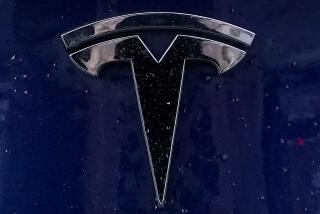Car rental firms race to locate recalled Toyotas, Vibes
The recalls of several Toyota models over the last month not only have sparked angst at Toyota dealerships but also have created headaches for car rental companies that offer the vehicles.
The nation’s largest rental companies have been rushing to pull thousands of recalled models off the road and assure renters that all the remaining cars are safe.
But it hasn’t been easy. After all, rental vehicles roll in and out at a fast pace all day long. So rounding up each recalled car, including those used for long-term rentals, has been a chore.
Enterprise Holdings Inc., the parent company for Alamo, Enterprise and National car rentals, owns 35,000 recalled Toyota and Pontiac Vibe vehicles out of a fleet of about 870,000 cars.
The Toyota models have been recalled to fix unintended acceleration problems. The Vibe shares much of its engineering with the Toyota Matrix.
Two days after Enterprise Holdings announced that its divisions would stop renting the recalled cars, the firm had pulled 50% of the troubled cars off the road. Four days after that, the company had rounded up a total of 83%. By now, nearly all of its recalled rental cars are either fixed or off the road awaiting repairs.
“It is a big undertaking,” Enterprise Holdings spokeswoman Laura Bryant said.
Meanwhile, the parent company of Avis and Budget rental cars began pulling 20,000 recalled models from the two companies’ fleets last month.
By this week, 97% of the recalled vehicles were off the road and had begun repairs, said John Barrows, a spokesman for Avis Budget Group Inc. The recall efforts have not been 100% successful in part because some customers who rented Toyotas and Vibes didn’t return them right away because they either didn’t know or didn’t care that the cars had been recalled.
“Some people came back and some didn’t,” Bryant said.
And just when it seemed the rental car industry had a handle on the problem, Toyota announced last week that it was also recalling 437,000 Prius and Lexus hybrids worldwide because of braking problems.
“We are still sorting through that,” Bryant added.
Fairplex making convention push
The Fairplex in Pomona, home to one of the nation’s largest county fairs, is known for carnival rides, deep-fried food and pig races.
But now Los Angeles government leaders and tourism boosters hope the publicly owned property will be recognized as a modern meeting spot for businesses.
Next week, Fairplex officials will join Los Angeles city and county leaders for a groundbreaking ceremony to begin construction of an 85,000-square-foot complex for trade shows, corporate meetings and other large gatherings.
The federal Economic Development Administration, the Small Business Administration, Los Angeles County and the city of Pomona have chipped in to pay the $30-million cost for the project, according to Fairplex officials. All profit from the new complex will be reinvested into the Fairplex, officials say.
To build the facility, crews will redesign an existing 35,620-square-foot exhibit hall and add a 50,000-square-foot building.
The project comes at a precarious time for the business travel industry. In 2009, nearly 75% of managers who plan travel for large corporations said they cut spending by as much as 30%, according to a survey of the National Business Travel Assn.
But the same group predicted that spending on business travel would increase in 2010.
By building the conference center, the Fairplex is jumping into a market loaded with large conference space. Southern California boasts more than a dozen facilities with 85,000 square feet or more of exhibit and conference space. That includes the Ontario Convention Center -- with 225,000 square feet -- only 10 miles away from the Fairplex, according to Cvent, an online firm that provides management software for meetings and conferences.
Still, Dwight Richards, vice president of operations for the Fairplex, said he believed the conference center would succeed by drawing regional gatherings. Plus, he said, the Fairplex could offer groups access to other fairground facilities, including the drag strip at the nearby Auto Club Raceway and the off-road racing course.
“There are not too many others who can compete with that,” Richards said.
Fake fleece you get to keep: $8
AMR Corp.’s American Airlines added a couple of new wrinkles to its menu of services and extras: a $50 standby fee and an $8 blanket-and-pillow set.
If you need to change your flight schedule for the same day to the same destination, you can go “standby” only by paying $50. The fee is waived for certain passengers, such as those with a business or first-class ticket.
The other new charge is for a blue simulated-fleece blanket and blow-up pillow that will be sold to passengers on domestic trips and on some international flights, beginning May 1. The blankets are complimentary in premium-class cabins and other international fights. (Yes, you must blow up the pillow yourself.)
But, of course, you get to take the blanket-and-pillow set home. The set comes in a clear zippered pouch with a coupon for $10 off a purchase of $30 or more at Bed, Bath & Beyond.
JetBlue Airways Corp. and US Airways Group Inc. already charge $7 for a blanket-and-pillow set. US Airways includes eyeshades and earplugs.
Southwest Airlines Co. got rid of all in-flight blankets recently to quell concerns that sharing the same blanket with thousands of other passengers could spread the H1N1 virus.
But if you want a blanket on an American Airlines flight, remember that the carrier doesn’t take cash for in-flight extras.
Feeling a chill? American takes all major credit cards and debit cards.






